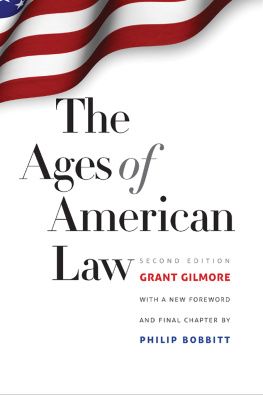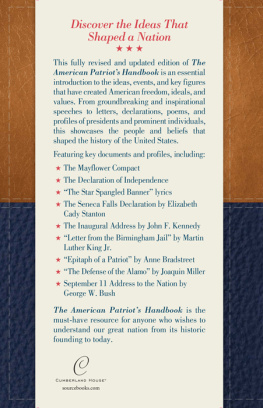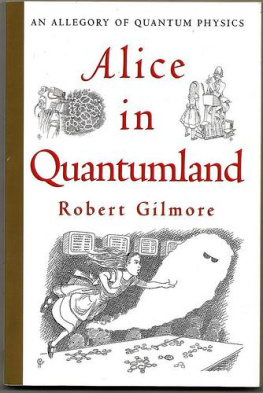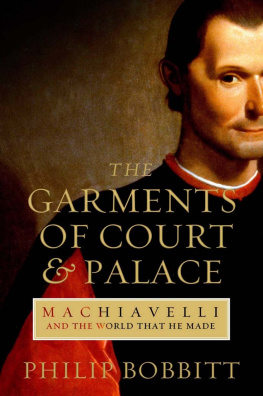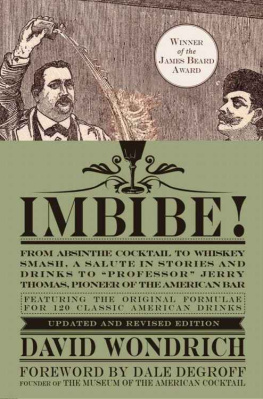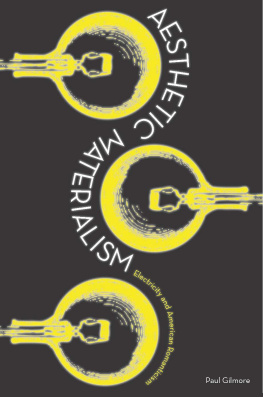Storrs Lectures on Jurisprudence Yale Law School, 1974
The Ages of American Law
Second Edition
Grant Gilmore
With a New Foreword and Final Chapter by Philip Bobbitt
Yale UNIVERSITY PRESS
New Haven and London
First edition 1977. Second edition 2014.
copyright 2014 by Philip Bobbitt.
Copyright 1977 by Yale University.
All rights reserved.
This book may not be reproduced, in whole or in part, including illustrations, in any form (beyond that copying permitted by Sections 107 and 108 of the U.S. Copyright Law and except by reviewers for the public press), without written permission from the publishers.
Yale University Press books may be purchased in quantity for educational, business, or promotional use. For information, please e-mail (U.K. office).
Printed in the United States of America.
Library of Congress Control Number: 2014941002
ISBN 978-0-300-18991-9 (pbk.)
10 9 8 7 6 5 4 3 2 1
Foreword
Philip Bobbitt
In late 2011, I was approached by an editor at Yale University Press, who was considering a revised edition of Grant Gilmores classic, The Ages of American Law. I responded that I would be pleased if the Press would publish, as a Foreword to such an edition, my 1975 essay in the Yale Law Journal introducing one of Gilmores lectures, The Age of Anxiety, which he reworked to form of the book. After reading that essay, the editor proposed that it be published as a historical document with a preface to provide context and that I should also draft a new section of the main text bringing it up to date, as apparently some readers wished in the classes in which the book is taught.
It is bracing to realize that something one once wrote can be referred to as a historical document, but I must concede that I am now at the same age Gilmore was when he delivered the lectures. Nevertheless I demurred, daunted by the prospect of adding a syllable to the main text of Gilmores masterpiece. When James Thurber was sounded out by a publisher as to whether he would be interested in doing the illustrations for a new edition of Alices Adventures in Wonderland, he was outraged. Keep the Sir John Tenniel drawings, Ill redo the text, he replied. That is rather the way I felt about tampering with Gilmore.
Yet I remained perplexed and indulged my perplexity the way I usually do, by procrastination. I had no desire to revise any of Gilmores formulations, and I therefore wrote the editor that it would be a mistake to add to the existing text of the book, which is so elegantly and insightfully written that it is certain to shame anything appended to it. Adding a final chapter by me would, I told her, be like putting a garage on the side of a William Delano townhouse.
At the same time, I very much wanted the book to stay in print, and I was aware that a survey of academics who used it in their courses had revealed some considerable sentiment for an updating and had disclosed some disquiet among first-year studentsa notoriously paranoid bunchthat they were being given outmoded materials to study. Perhaps to accommodate that concern, I should accept the proposal and do what I could, owing to my affection for Gilmore and my history with the origins of the book. That history will take a little explaining.
During the academic year 197475, Gilmore and another professor at the Yale Law School, Robert Cover, supervised a writing course in which I was the only student. Cover had just published his remarkable Justice Accused, which, accepting Karl Llewellyns historical and jurisprudential genealogy of Grand and Formal Styles, attempted to account for the deplorable transition from the one to the other that Llewellyn had described in his magisterial The Common Law Tradition: Deciding Appeals. Cover dated this transition a generation earlier than Llewellyn, locating its origin in a particular class of antebellum cases involving slavery: [I]n slavery, the 1840s and 1850s were not a golden age of free-wheeling policy jurisprudence [in the Grand Style] but an age of the retreat to formalism.
Gilmore was intrigued with Covers thesis and planned, I learned, to structure his Storrs Lectures later that year around the Llewellyn typology. It was my aim, in the blithe way of students whose ignorance gives an unwarranted but indispensable confidence to their precocity, to show Cover and Gilmore that Llewellyns essential premisethat American jurisprudence of Grand and Formal Styles reflected a sharp break in judicial argumentwhile an interesting heuristic, was an elusive if not arbitrary distinction. Why these two masters were prepared to indulge me in this fantastic conceit remains a mystery, but indulge me they did, and at the end of the year I produced a 300-page essay that they mercifully acceptedand honoreddoubtless with the requirement that I graduate immediately.
Once a week, most weeks, Gilmore and I met at Morys for lunch. In the beginning, and for some months, we acted out the familiar struggle of tutor and advisee in which the tutor tries to confine the proposals of the advisee to some manageable topic and the advisee attempts to evade any reasonable constraints in order to take up a subject as vast as he can negotiate. Gilmore wanted me to test my theory by examining the judicial constructions of the Carriage of Goods by Sea Act over a one-year period in the 1880s. I wanted to examine every recorded opinion in which a state or federal court had
At the time, I was an article editor for the Yale Law Journal. When I learned that Gilmore was going to deliver the Storrs Lectures during that year, I began a campaign to persuade the Journal board, and Gilmore himself, that we should publish one of the lectures in the Journal. The Storrs Lectures are, I surmise, the most prestigious series of such addresses in American law. Lon Fuller used one such series to deliver The Morality of Law; others have been given by Roscoe Pound, Robert Hutchins, Bruce Ackerman, and most notably, Benjamin Cardozo, whose The Nature of the Judicial Process was auditioned in New Haven with much trepidation by its author who feared that his confession that in some rare cases a judge did not simply locate the applicable law and mechanically apply it would so shock the country that it would foreclose his elevation to the U.S. Supreme Court. (It didnt.)
Gilmore came at the end of a period of importance and prestige for law professors that I do not think is likely to be repeated. Even then, however, he was a very significant figure among the elect. The breadth of his workin addition to being the most important academic of his generation in commercial law, he also coauthored, with his close friend Charles L. Black, Jr., the leading treatise on admiralty lawis unusual. Furthermore, the depth of his workhe was awarded the Ames Prize by the Harvard law faculty for his two-volume treatise on security interests in personal property, the single most distinguished work of the period, in addition to his being the principal draftsman of Article 9 of the Uniform Commercial Codewould have been remarkable in any era.
He stood in apostolic succession, jurisprudentially, to Arthur Corbin and Karl Llewellyn, the commercial law giants of two earlier generations, but neither of them could have written The Ages of American Law because Gilmore came at the end of the era of Legal Realism, an era that they had begun. The Ages of American Law is not really a book of legal history, a field as to which Gilmore was a committed skeptic, and I am glad to see that its use has not been confined to such courses. Rather it is a meditation on the evolution of law in the United States, a society that began as the bumptious child of English common law and eventually developed the most advanced methods of legal pragmatism, methods that are only now beginning to be adopted in the United Kingdom and around the world. As such,
Next page
